This post may contain affiliate links. Please read our disclosure policy.
Beef madras is a hot and fragrant Indian curry with tender beef simmered in a rich, spiced tomato and onion gravy. This one-pot recipe is suitable for all tastebuds, but it’s easy to make your curry as spicy or mild as you’d like!
Make this beef madras curry into a family-style feast with fragrant cumin rice and homemade naan bread. And if you’re feeding a crowd, add a second curry, like chicken korma, for the table.
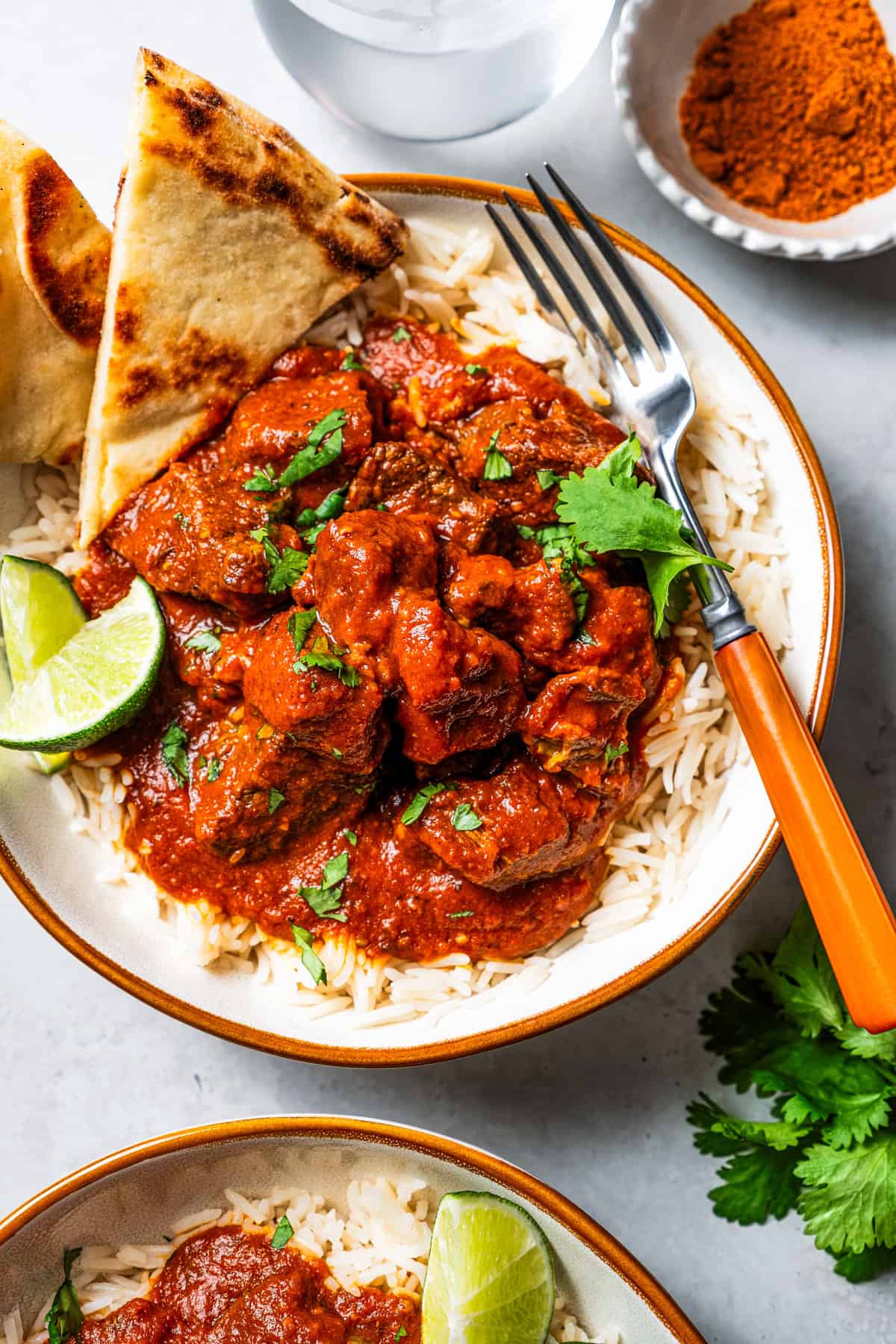
You’ll find many authentic curry recipes with long lists of ingredients and spices that can be overwhelming. I’ve done my best to simplify this beef madras curry to make it accessible to most kitchens, even if you don’t make curry often. As in, this recipe uses common ingredients, and the method is no more complicated than preparing a beef stew! It comes down to an onion base, which is the secret to homemade curries that taste just like what you’ll find in Indian restaurants.
Things to Know About This Madras Curry Recipe
- Blended onion base. Many restaurant curries start with a smooth onion sauce as a flavor base. While some homemade versions skip this onion paste, I think it’s pretty essential for an authentic, curry house-style madras (plus, you can use this paste for more curry recipes, like tikka masala). I make a quick version using the blender!
- One pan. This madras curry needs time to simmer on the stovetop, and you’ll sear the beef and prepare the sauce in the same pot. Not only is it key to building flavor, but it also makes cleaning up afterward super easy. I also include oven directions.
- Adaptable. Traditional madras curries are made hot and spicy with chili peppers and curry powder. I’ve kept the curry powder but left out the chilies in this recipe to make it milder and suitable for everyone (even kids!). Of course, if you prefer a fiery curry, you can always add fresh chilies or chili flakes to the sauce or as a garnish.
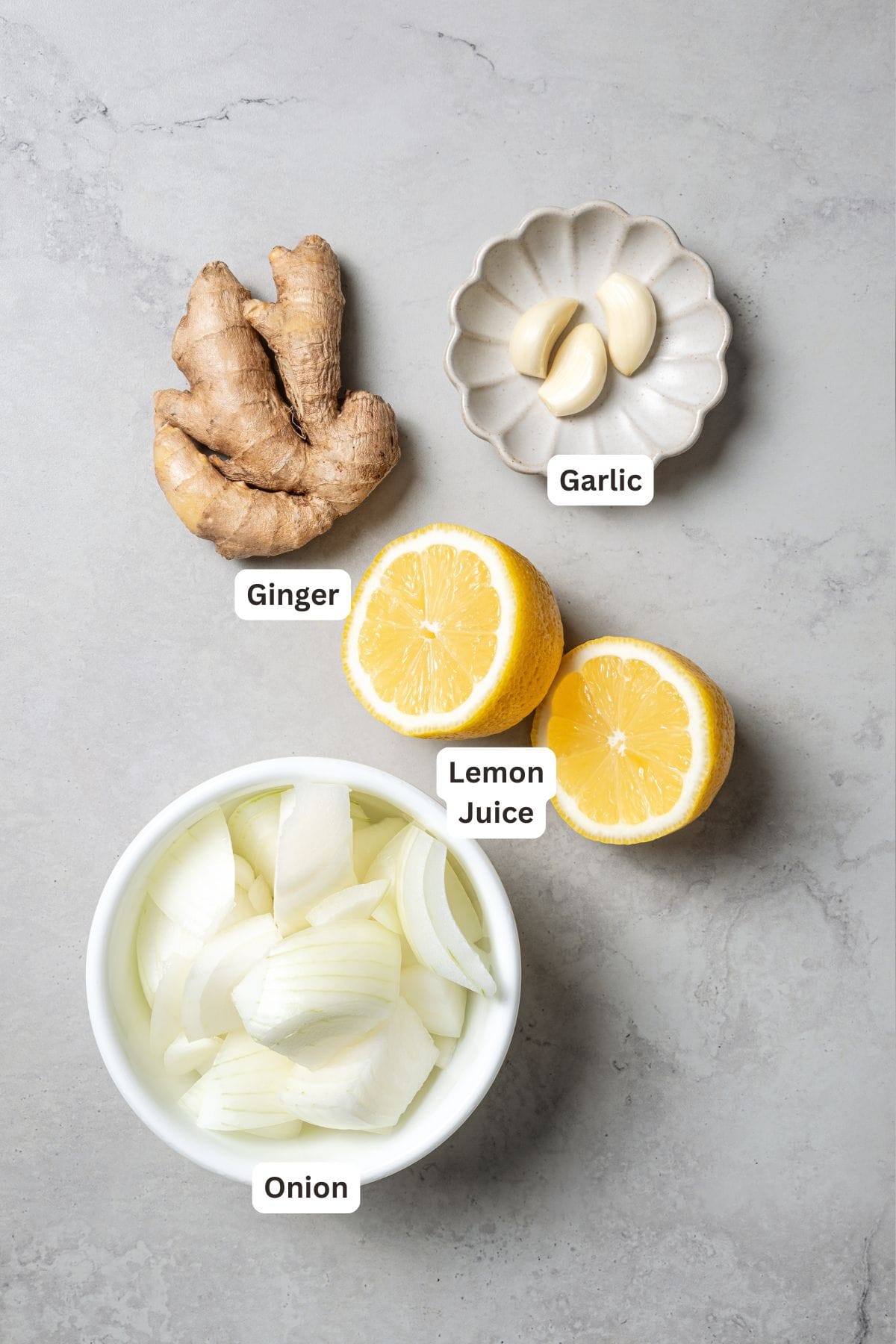
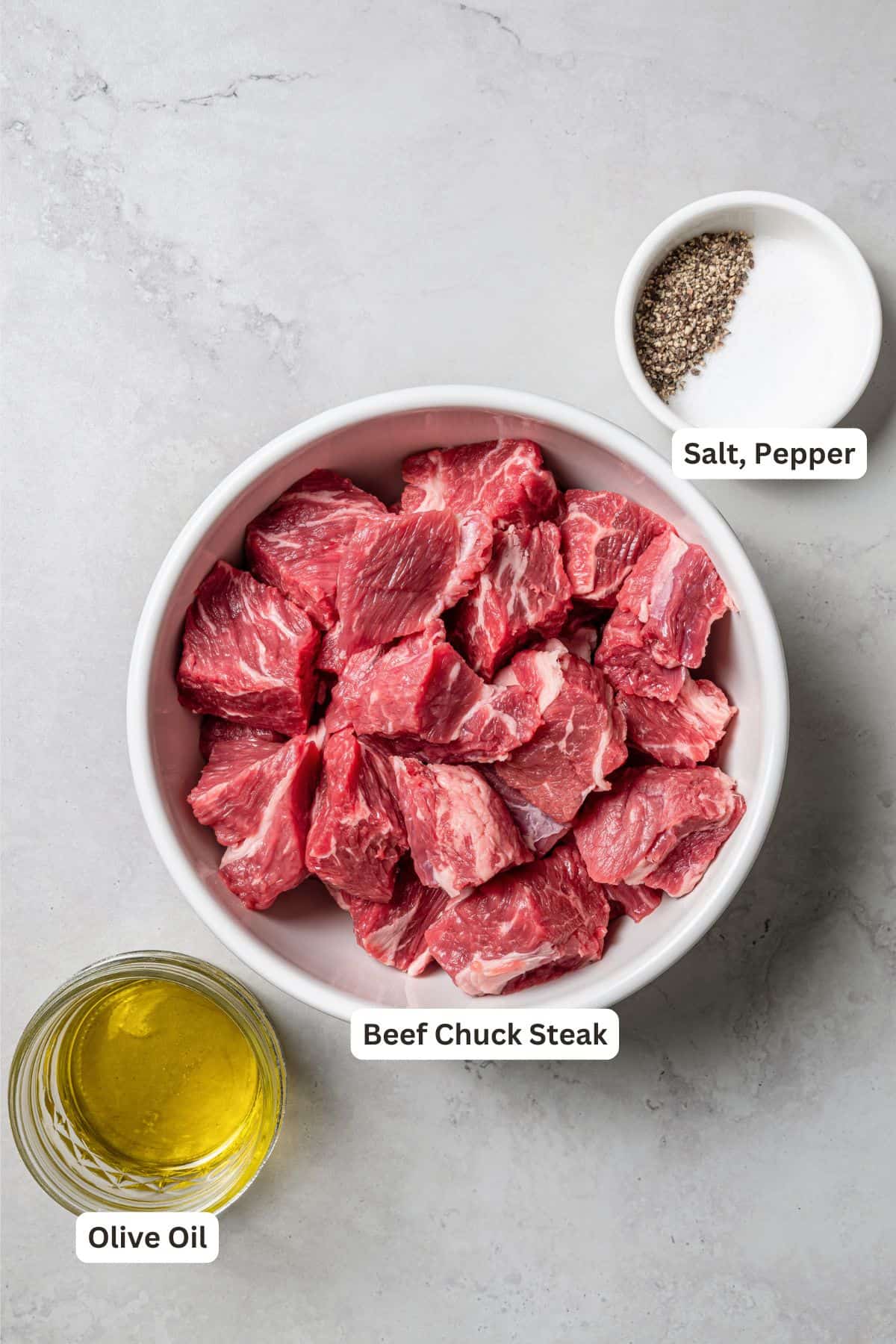
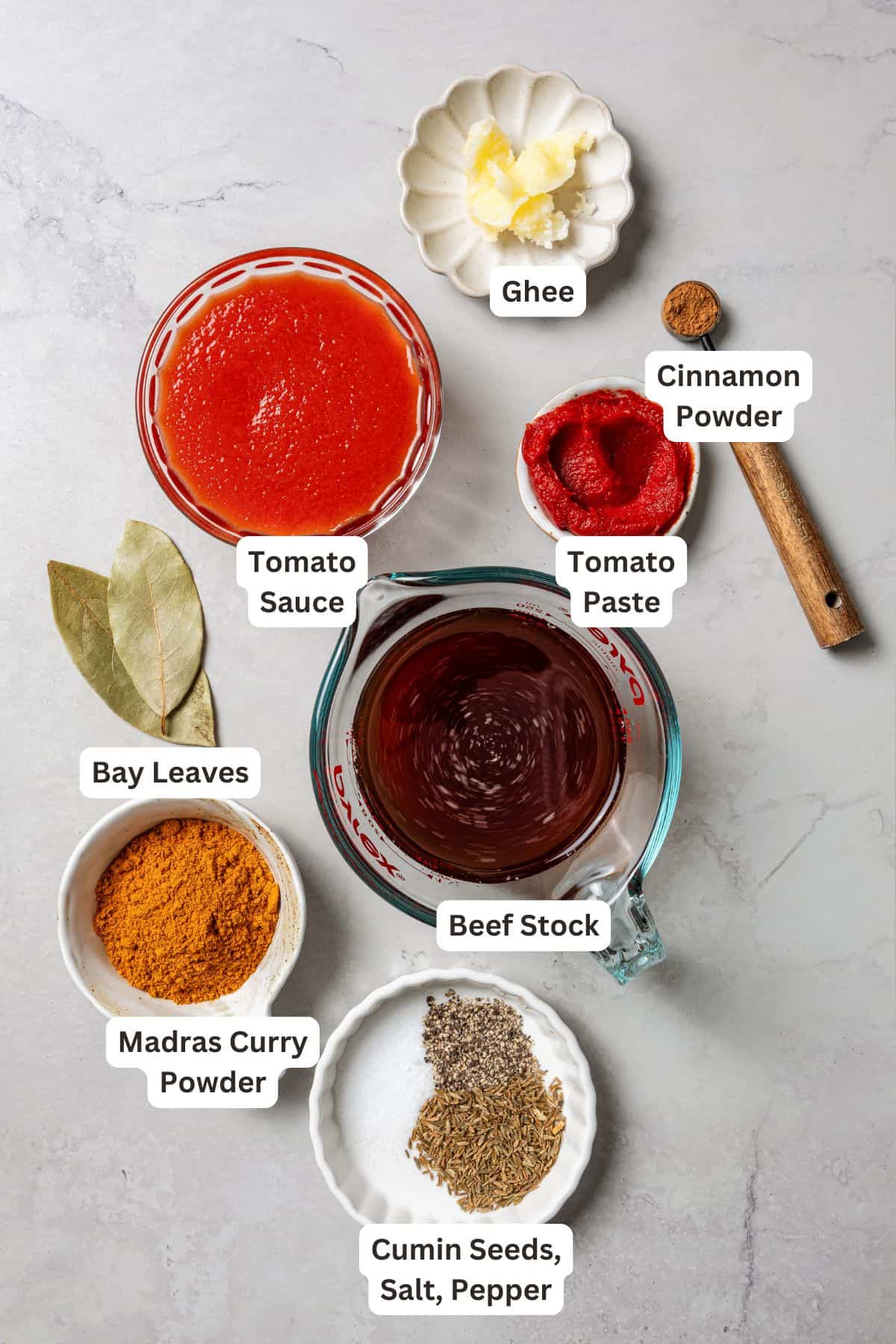
Ingredients You’ll Need
Below are the ingredients used in my homemade madras curry. The complete ingredients list with amounts is in the recipe card below the post, followed by a step-by-step overview with photos.
- Onion – I recommend a large yellow onion, peeled and roughly chopped.
- Lemon Juice – This is also best if it’s fresh, however, you can use bottled lemon juice in a pinch.
- Olive Oil – Or your choice of cooking oil, for searing the beef.
- Beef – I use beef chuck as it’s flavorful and good for slow-cooking. Another option is skirt steak, or you can make this curry with another protein, see below.
- For the Madras Curry Sauce
- Ghee – Ghee is a type of clarified butter used in Indian cooking. Regular unsalted butter will work as a substitute, or you can use coconut oil.
- Spices – Cumin seeds, bay leaves, cinnamon, and Madras curry powder, in addition to salt and pepper. You’ll find the spices you need in the spice aisle or the international food aisle at most major grocery stores. If you don’t have cumin seeds, substitute ¾ teaspoon of ground cumin per teaspoon of seeds (or to taste).
- Tomato Paste and Tomato Sauce – Choose your favorite brand from the store. If needed, you can substitute tomato paste with additional tomato sauce in a pinch.
- Beef Stock – I like to use beef stock or beef broth since we’re making a beef curry. That being said, you can substitute chicken stock or vegetable stock. The flavor won’t be quite as rich.
Can I Use A Different Cut of Meat?
This madras curry is all about the sauce, so the protein is flexible! I make mine with beef chuck steak. I’ve seen recipes that use cuts like skirt steak or beef rump, which cook much faster than stewing meat. I tend to favor slow-cooking cuts, though, as I find it’s better for building flavor.
You can also swap the beef with chicken or lamb. If you’re pressed for time, you can even use pre-cooked meat, like tandoori chicken. Or, make it with chickpeas, vegetables, or paneer (a fresh, non-melting cheese from South Asia used in vegetarian curries). Keep in mind that the cooking times will vary depending on your ingredients.

Recipe Tips
- Avoid non-stick pots and pans. Nonstick pans are handy to have, but not when it comes to cooking curries! The idea is to have the curry sauce caramelize against the side of the pot, which you’ll deglaze with stock to lift any browned bits. I recommend a Dutch oven or a stainless steel/aluminum pot. All that caramelization adds flavor to the curry, which you just won’t get with a nonstick pan.
- Balance the flavors. If you find the flavors a bit sharp or acidic, skip the lemon juice in the onion paste and add ½ teaspoon of tamarind paste to the sauce instead.
- Make it sweeter. For a sweeter curry, stir in a little mango chutney (or a little brown sugar). Add a small amount at a time and taste as you go. Remember, you can always add, but you can’t take away. You could also try it with my rhubarb chutney.
- Blend the sauce. Madras curries originated in the UK, where Indian restaurants often blend the sauce for a silky-smooth texture. Rather than blending the finished sauce, I opt to blend the onion base only. If you prefer a super smooth curry sauce, go ahead and add the finished sauce to the blender (without the beef). Make sure it’s a blender with an open lid for the steam to escape.
What to Serve With Beef Madras
Turn this beef madras curry into a meal with fluffy steamed basmati or jasmine rice, or vegetable biryani on the side. Kick things off with homemade samosas or this snack platter-style Indian samosa chaat, and don’t forget soft naan bread or crunchy poppadoms. Serve with chutney, raita (the Indian version of tzatziki or Macedonian taratur, great for taming spicy food!), or sambals.
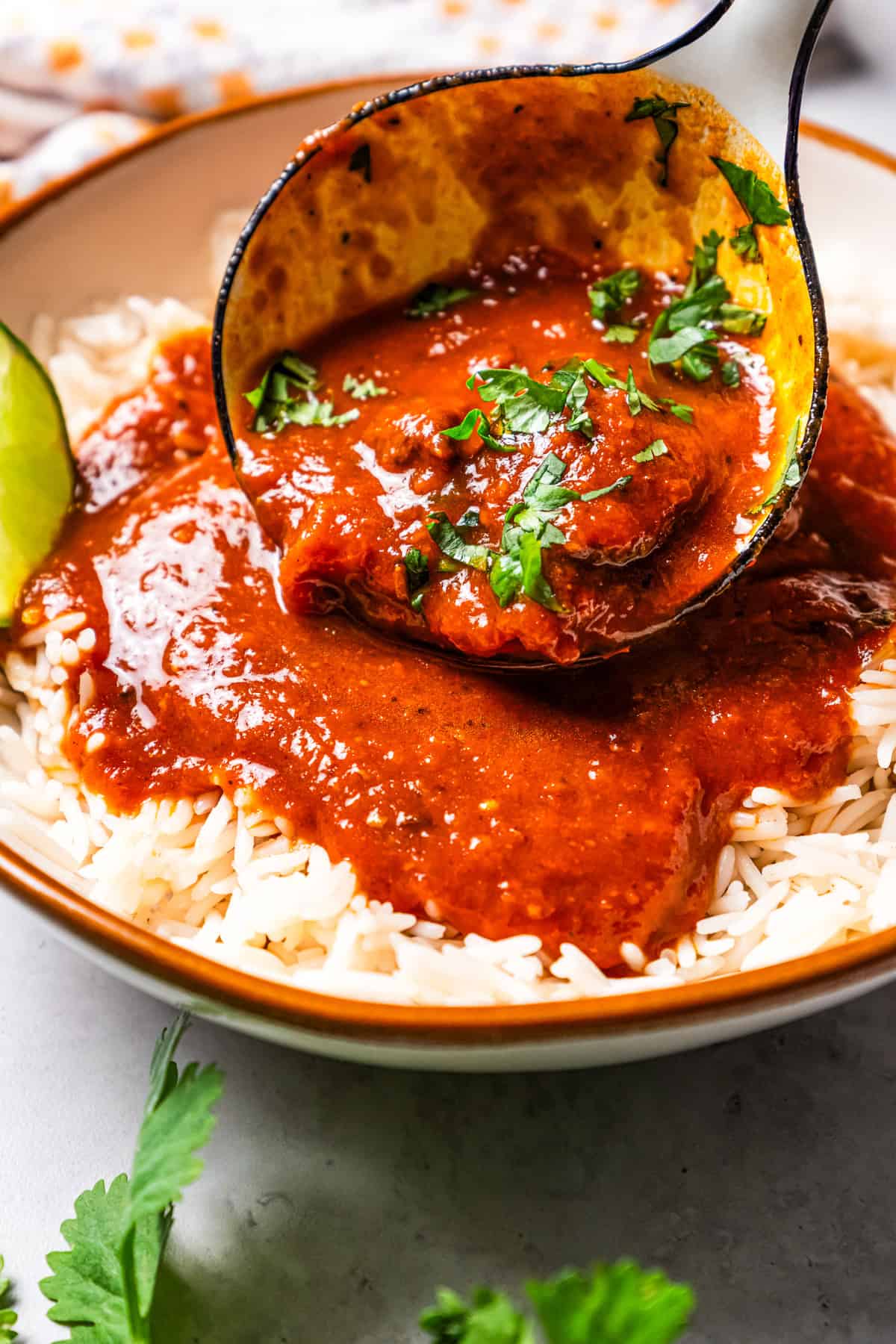
Make It Ahead
This madras beef curry has a few different components, so it’s a great recipe to prep in advance. Prepare the onion paste, or you can even sear the beef and prepare the sauce a day or two ahead of cooking. Keep everything in separate airtight containers in the fridge. When you’re ready to make your curry, simply combine the ingredients and simmer as directed.
Pin this now to find it later
Pin It
Beef Madras Curry
Ingredients
For the onion paste:
- 1 large onion, peeled, roughly chopped
- 3 cloves garlic, peeled
- 1 inch piece of fresh ginger, peeled and roughly chopped
- 2 tablespoons lemon juice
For the beef:
- 2 tablespoons olive oil
- 1¼ pound beef chuck steak, cut into 1-inch cubes
- salt and freshly ground black pepper, to taste
For the sauce:
- 1 tablespoon ghee
- 2 bay leaves
- 1 teaspoon cumin seeds
- 2 tablespoons tomato paste
- 3 tablespoons Madras curry powder
- ½ teaspoon cinnamon powder
- 2 cups beef stock, or beef broth
- 1½ cups tomato sauce
- salt and freshly ground black pepper, to taste
Instructions
- Make the onion paste. Add onion, garlic, ginger, and lemon juice to a food processor. Process until you have a paste. Set aside.
- Cook the beef. Heat half the oil in a pot or a Dutch oven set over medium-high heat. Add half of the cubed beef, season it to taste with salt and pepper, and cook until browned on all sides. Remove the beef from the pot and place it into a bowl. Repeat with the remaining beef. Once browned, add it to the bowl with the previously cooked beef. Set it aside.
- Make the curry sauce. Melt ghee in the same pot over medium-high heat. Add bay leaves and cumin seeds. Cook until the cumin seeds pop. Then add tomato paste and prepared onion paste, along with Madras curry powder. Cook, stirring for 2-3 minutes.
- Deglaze. Add the beef stock and stir to deglaze the pot, removing any browned bits from the bottom. Add the tomato sauce and bring to a boil.
- Add the beef. Add the browned beef to the prepared sauce. Reduce heat and simmer the beef, partially covered with a lid, for 1 hour and 45 minutes, or until tender.
- Thicken the curry. Uncover the curry and simmer for another 15 minutes, or until the sauce is lightly thickened. If your curry looks dry, add some hot water.
- Serve. Serve the curry warm, garnished with chopped coriander and desired side dish, steamed rice, or naan bread.
Equipment
Notes
- You can make this curry in the oven, but use a Dutch oven. Once you have assembled your curry, cook it in the oven at 320°F for 3 hours.
- Beef chuck is the best meat cut for the curry because it is flavorful when slow-cooked. You can also try skirt steak.
- If you feel like your curry has more acidity, then instead of lemon juice, use tamarind paste. Only ½ of a teaspoon will be enough. Add it to the sauce step.
Nutrition
Nutritional info is an estimate and provided as courtesy. Values may vary according to the ingredients and tools used. Please use your preferred nutritional calculator for more detailed info.
How to Make Beef Madras Curry (From Scratch With Photos)
Curry is one of those dishes that shouldn’t be rushed. With a little patience, you’ll be rewarded with fall-apart-tender beef and a rich, layered curry sauce. Follow the steps below:
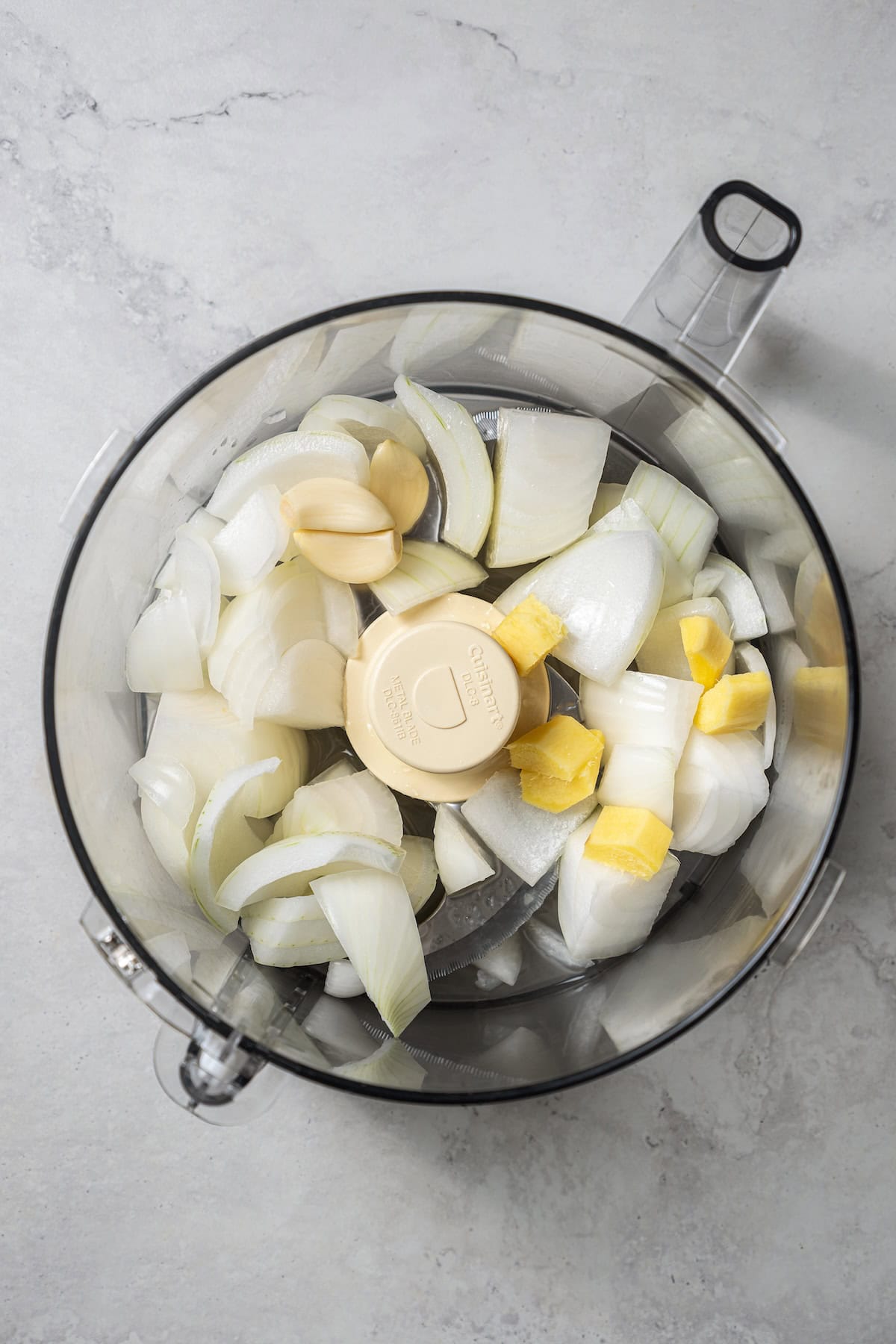

- Make the onion paste. To begin, blend onion, garlic, ginger, and lemon juice in a food processor to make a thick paste. This will be your flavor base. Set that aside for now while you start with the rest of the curry.
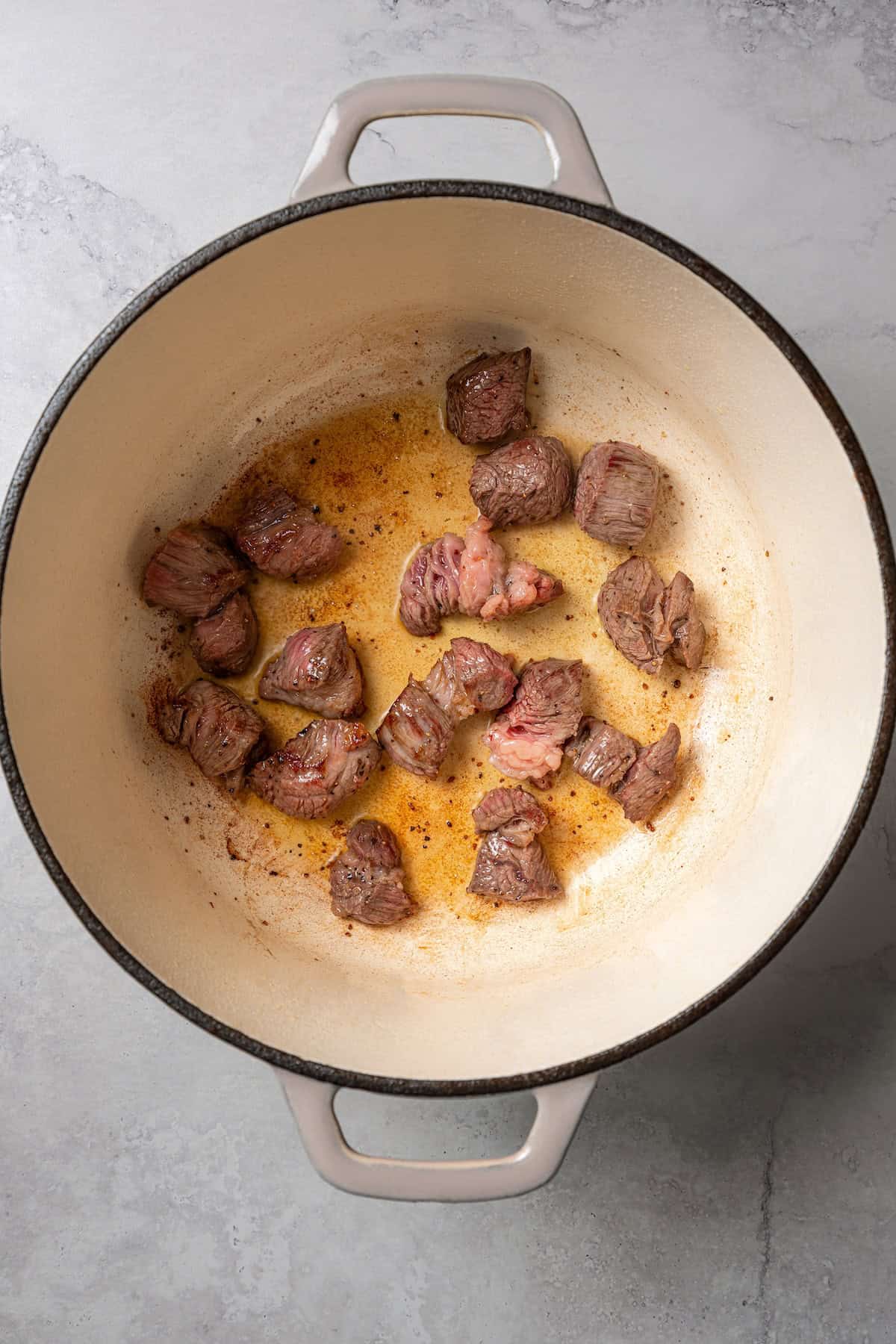

- Cook the beef. Next, heat oil in a large saucepot. Cook the beef in batches over medium-high heat so it’s browned on all sides. Season the meat with salt and pepper while it cooks, and transfer the cooked beef to a bowl.
- Make the sauce. In the same pot, melt the ghee. Sauté the bay leaves with the cumin seeds until the seeds start to pop, then add the tomato paste, onion paste, and curry powder. Stir while that cooks for a couple of minutes and becomes fragrant.
- Deglaze the pot. Now, pour in the beef stock. Gently scrape up any browned bits from the bottom and sides of the pot, stirring them back into the sauce. Afterward, add the tomato sauce and bring the pot to a boil.
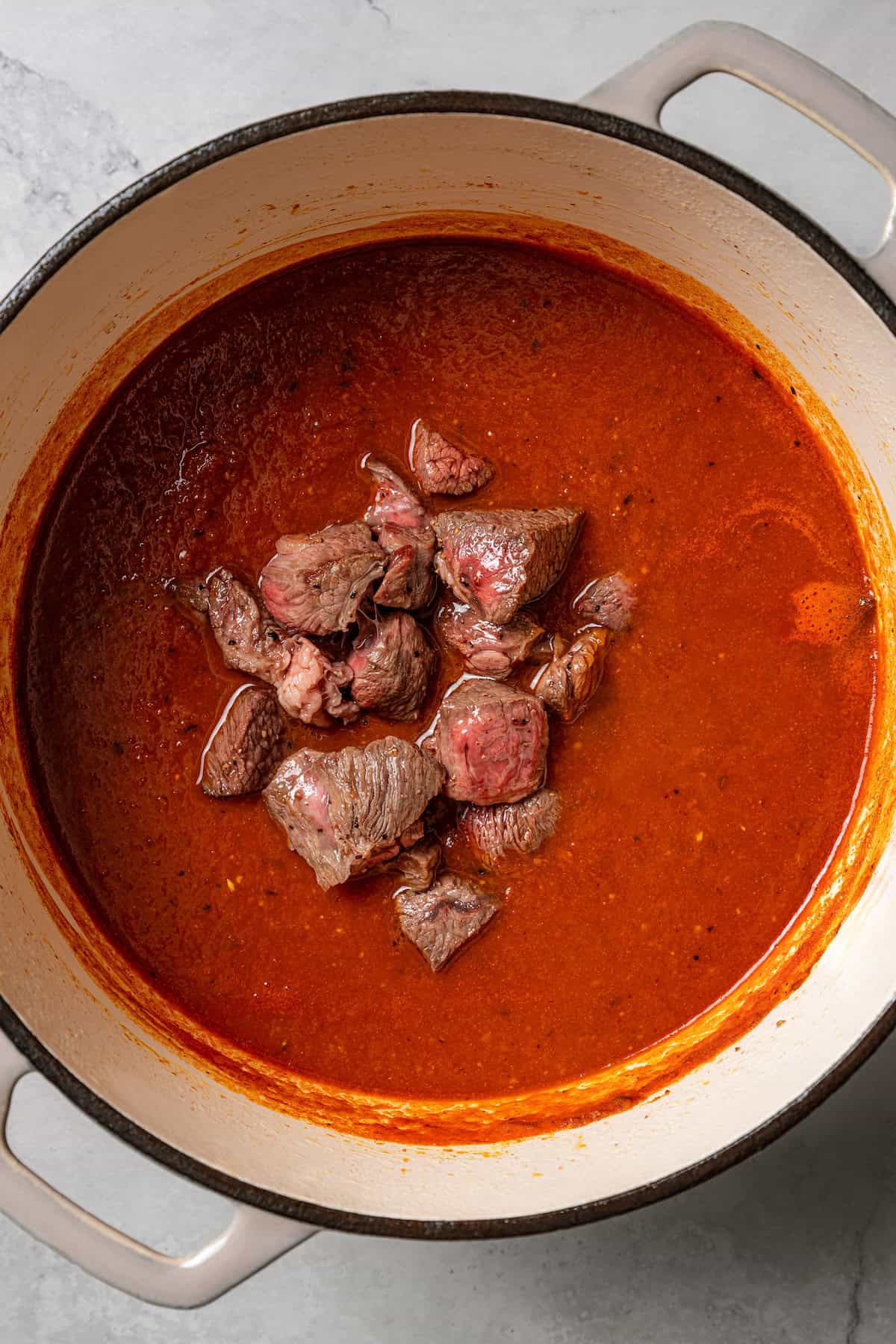
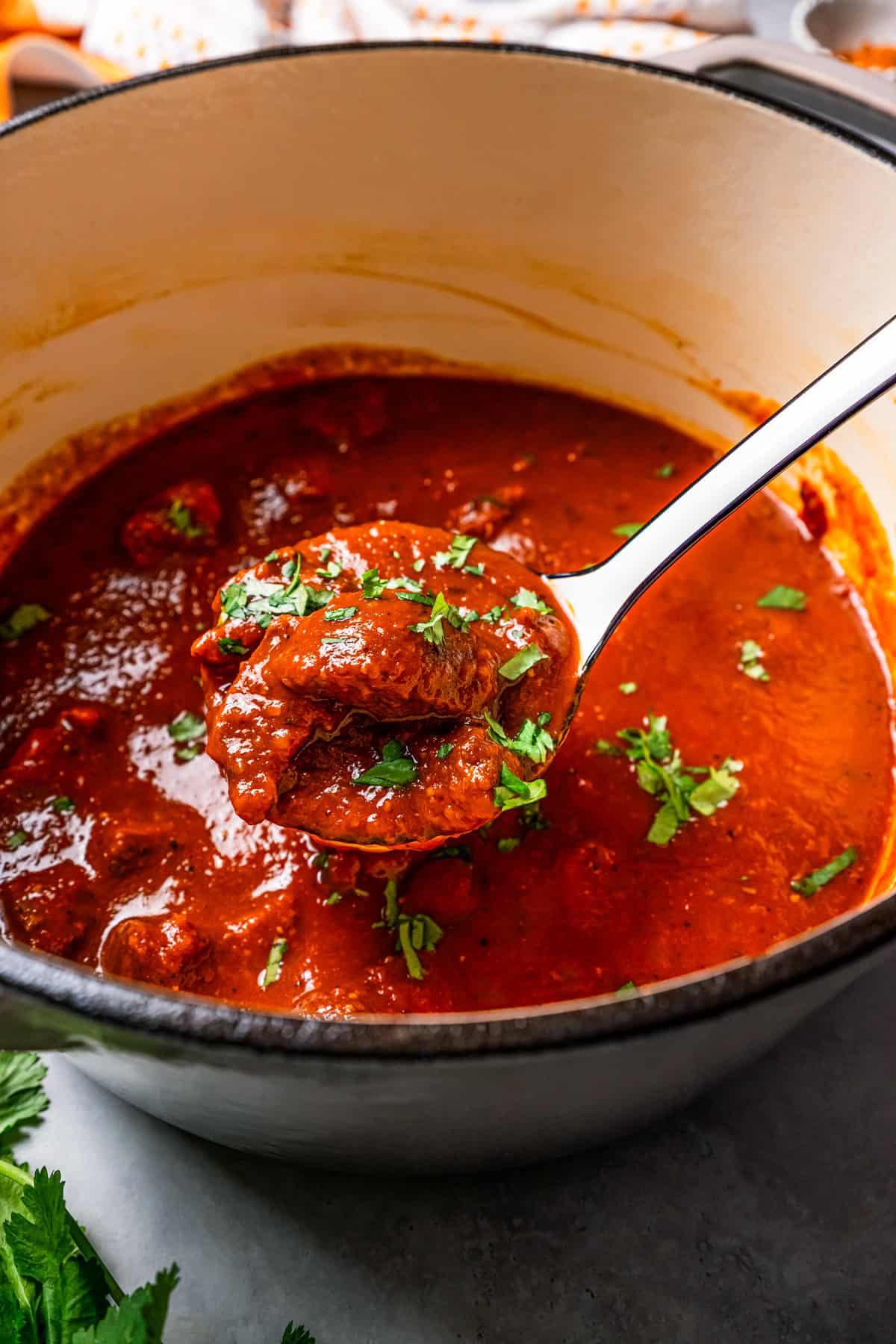
- Assemble the curry. Add the beef back into the pot, and lower the heat to a simmer. Let the curry cook over low heat, partially covered, for about 1 hour and 45 minutes. Once the beef is tender, remove the lid and simmer the curry uncovered for 15 minutes to thicken. You can add a little water if you find it’s thickened too much.
- Serve. Dish up your madras curry warm over rice with fluffy naan, garnished with fresh coriander, and enjoy.
Oven Method
When I have the time, I love slow-cooking this madras curry in the oven. Assemble the curry inside a Dutch oven or oven-proof pot with a lid, cover it, and cook it in the conventional oven at 320ºF for 3 hours, until the meat is tender.
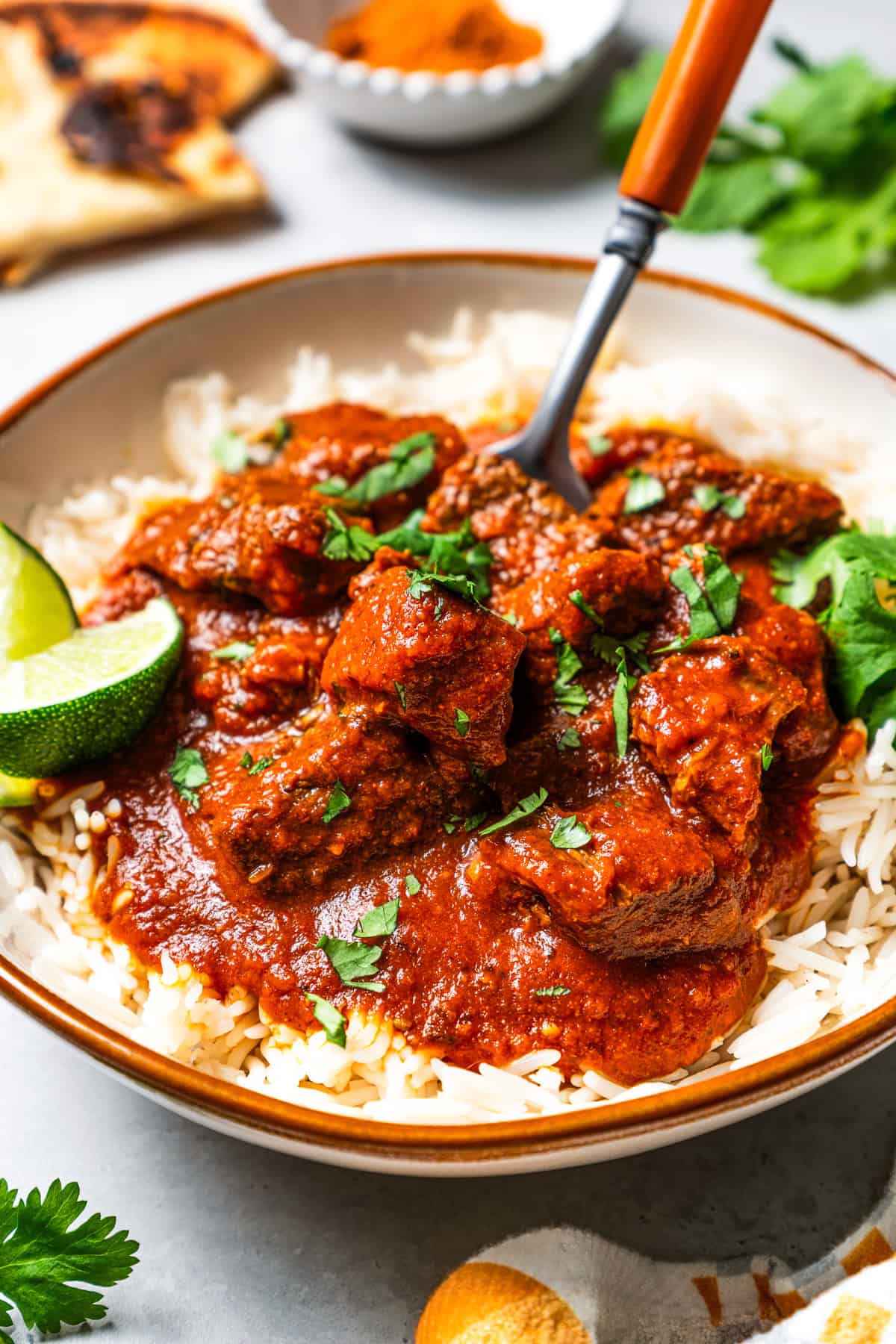
Storing and Reheating Leftovers
- Refrigerate. Keep any leftover beef madras in an airtight container in the fridge for up to 3-4 days.
- Reheat. The easiest way to warm curry is in the microwave or on the stovetop. Stir it often so that it heats through evenly.
- Freeze. Unlike curries that contain dairy, like yogurt, this beef madras curry freezes well! Store it in airtight containers and freeze leftovers for up to 2 months. Thaw the curry in the fridge before you reheat it.









